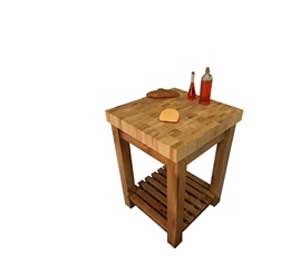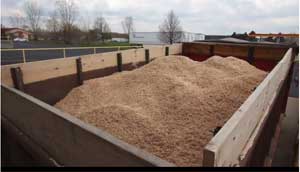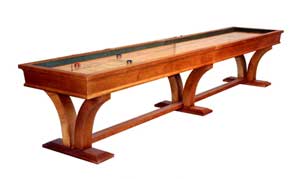
Todd McClure’s involvement in woodworking came about in a roundabout way: “I was more of a sales and marketing guy than a woodworker. My woodworking experience was building a wooden crate to ship the billiards table in,” he said.
As a game table seller, Todd got into selling shuffleboard tables a few years ago. “I started off as a wholesale distributor, and contractor, but when you’re a contractor, it’s hard to get the quality you want, and hard to respond to customers and get customization.”
So, about five or six years ago, he bought shop equipment, hired people who had previously worked in the furniture industry around the Grand Rapids, Michigan, area, and began making his own game tables, specializing in shuffleboard.
“Shuffleboard was really big in America in the late 50s,” Todd said, and although it’s not quite as common anymore, most of his customers are people on the high-end of the market, who own two or three homes. “They’ve done game rooms before, with the pool table or the foosball table, and found out those are noisy.
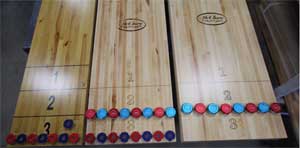
“Shuffleboard’s a quiet game, so there’s more socializing, and people from age eight to age 80 can play. Plus, it’s a long, skinny thing so it can go along a wall rather than being out in the middle of the floor.”
The shuffleboard playing surfaces themselves – when Todd talks about “the boards,” that’s what he means – are made out of hard maple, two or three inches thick, with most of the wood coming locally from Michigan. (McClure Tables will also sometimes use reclaimed wood, fromsources such as old barn buildings in Michigan or Indiana.)
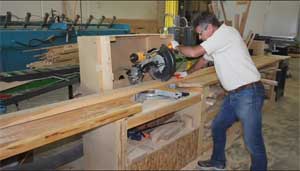
Todd, who has learned about running shop machinery and doing woodworking from the former furniture industry people he hired, says he’s usually involved in making the boards. “A shuffleboard playing surface is a big block of butcher block.”
“Most woodworkers know how to edge glue a cutting board, and before you edge glue, you have to surface the wood,” Todd said. When McClure Tables is making shuffleboards, he said, they want to work with fresh wood. “We won’t start surfacing the wood if we’re not going to glue it up within one or two days.”
Since the glue (a radio press variety from Franklin) has an open time of 10 or 15 minutes, if the glue-up were to occur manually, using hand clamps, “By the time you get to the last clamp, 10 or 15 minutes has passed, and the wood is not fresh anymore.”
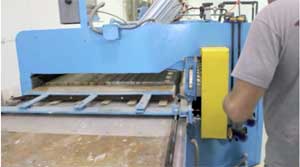
Instead, McClure Tables has what Todd describes as a “huge” radio frequency press. “In about four minutes, we can get it glued up, and cut down on open time,” he said. Plus, the radio frequency cures the glue quickly, in a process similar to using a microwave oven. “Even a guy who can build his own cabinet, a lot of times is better off coming to us for the board. And we do sell the boards themselves, about a dozen a year, to people building their own cabinets.”
That would be the cabinets that house the shuffleboard playing surface, which are built using chop saws, rip saw, band saws: “Other than the press, it’s nothing that the typical homeowner or small cabinet shop might not have. There’s no CNC here; the most computerized thing we have here is two of our sanders have some digital readouts,” Todd said. About 80 percent of the shuffleboard cabinets are made from maple, but poplar, pine, hickory, cherry and others are also possibilities, with some models having different woods on the trim.
Todd designs most of the shuffleboard cabinets; many of them are patterned after pool tables, but “who knows where inspiration comes from?” he asked. “I might be in a museum and see a coffee table and think ‘That would make interesting legs on a shuffleboard cabinet.’”
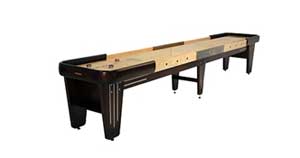
A couple of his favorite designs are the Veneto, named for a region in Italy, which came from a customer who asked “Can you make something that matches my pool table?” and the Rock-Ola. The Rock-Ola company, best known for making jukeboxes, also made shuffleboard tables in 1948 and 1949, but never trademarked them. Todd licensed the name in 2010, and his company makes exact replicas of the 1940s Rock-Ola shuffleboards.
“It takes about 60 to 70 manhours to build a Rock-Ola; a Veneto is about 50 hours,” Todd said. “The typical board is about 15 hours of production time, from getting the raw wood, to finished.”
The finish used on the shuffleboard surfaces is a proprietary spray acrylic dubbed McClure Durable Acrylic; the company also has branded finishes for use on countertops, chopping surfaces and table tops.
With the ability to easily glue up butcher blocks, the company has found a natural expansion beyond shuffleboards into building custom countertops and cabinetry using the butcher block process. Some of their wood goes to other destinations as well: “When you buy a board foot ofwood, you might use 75 percent of it in cabinetry. We get a 45 to 50 percent yield in butcher block,” Todd said. “We lose about 25 percent when it gets cut off from the raw wood; we give that to people for their local woodburners.” More “gets cut up or chopped off or sanded away into sawdust.” The sawdust goes to local farmers. “If I’m paying $2 a board foot for maple, it’s costing me $4, because half of it I can’t use,” Todd said.
Still, he said, making the shuffleboards, and the cabinets, is “a lot of fun. I’ve sold people things my whole life, and there’s a certain amount of pride in selling somebody something you had a hand in yourself. Now, as a manufacturer that sells my own stuff, I feel like it’s the best of both worlds. When you build it yourself, you’re in charge; you’re in control.”
(Oh, and if you’re wondering how to play shuffleboard, the McClure Tables website does have handy sections on “How to Play Shuffleboard,” plus variations of the rules.)
